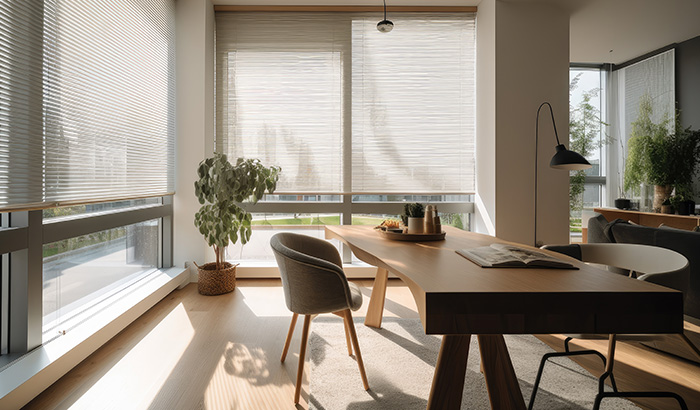Lighting is a fundamental aspect of the workplace environment that significantly influences employee productivity. The quality and design of lighting systems can profoundly impact various aspects of employees’ physical and mental well-being, ultimately affecting their efficiency and job performance.
In this article, we will explore 24 ways lighting can impact employee productivity, offering detailed insights into each aspect.
- Visual Comfort and Acuity: Optimal lighting levels ensure employees can perform tasks comfortably without straining their eyes. The right brightness and color temperature reduce eye fatigue, headaches, and blurred vision, facilitating sustained productivity. Employers should consider illuminance levels (measured in lux) suitable for specific tasks and workspaces to achieve visual comfort. For general office areas, 300-500 lux is recommended, while for detailed tasks, such as reading or design work, 500-1,000 lux is ideal.
- Circadian Rhythm Alignment: Lighting significantly impacts employees’ circadian rhythm, which regulates their sleep-wake cycle. Exposure to natural or dynamic lighting systems that mimic sunlight helps align the body’s internal clock with the external environment, increasing alertness and focus during working hours. Using tunable white lighting fixtures that simulate the color temperature of natural daylight throughout the day can promote circadian alignment and optimize productivity.
- Mood Enhancement and Employee Morale: The lighting quality can influence employees’ mood and emotional well-being. Warm lighting with soft hues creates a cozy and inviting ambiance, fostering positive emotions and improving employee morale, motivation, and job satisfaction. Employers can introduce variable lighting scenes to match different activities and moods, such as warm lighting for relaxation areas and brighter lighting for collaborative spaces.
- Reduction in Absenteeism: Unsuitable lighting conditions can lead to physical discomfort and health issues, such as eye strain and migraines, increasing the likelihood of employee absenteeism. Employers can create a healthier workspace by implementing optimal lighting solutions, reducing sick leaves, and enhancing overall productivity. Consider conducting surveys or assessments to identify potential lighting-related issues and invest in ergonomic lighting solutions.
- Improved Alertness and Attention: Light spectrum can influence brain activity and alertness. Blue-enriched lighting, in particular, has been shown to stimulate the brain, enhancing alertness and cognitive function. Employees exposed to such lighting tend to be more attentive, responsive, and focused on their tasks. Integrate dynamic lighting systems that gradually shift from cool, blue-enriched light in the morning to warmer, calming light in the evening to optimize employees’ attention and performance throughout the day.
- Task-Specific Lighting Solutions: Different work activities require specific lighting conditions. Implementing task-specific lighting, such as adjustable desk lamps or focused overhead lighting, allows employees to tailor their workspace lighting to suit their needs, improving task performance. Task lighting should be easily adjustable to accommodate various tasks and individual preferences, ensuring employees can personalize their lighting to optimize efficiency.
- Minimized Errors and Accidents: Proper lighting reduces the likelihood of errors and accidents in the workplace. Clear and sufficient lighting helps employees read instructions, labels, and documents accurately, reducing the chances of mistakes resulting from poor visibility. Employers should conduct regular lighting audits to identify areas with inadequate illumination and promptly address them to enhance safety and prevent errors.
- Enhanced Creativity and Innovation: Lighting can influence the creative process by setting the mood in the workplace. Soft, warm lighting can create a comfortable and inspiring atmosphere, fostering creativity and innovative thinking among employees. Consider implementing lighting designs that allow for adjustable color temperatures and intensity to promote creative thinking in creative spaces such as design studios or brainstorming rooms.
- Energy Efficiency and Environmental Impact: Employing energy-efficient lighting solutions, such as LED lighting, reduces operating costs and demonstrates a commitment to sustainability. Employees may be motivated to align with the company’s green initiatives, potentially increasing their dedication and productivity. Organizations should invest in energy-efficient lighting technologies and implement motion sensors or smart lighting controls to optimize energy consumption in unoccupied areas.
- Personalized Lighting Control: Empowering employees to control their workspace lighting can significantly impact productivity. Personalized lighting control allows employees to adjust lighting levels according to their preferences and work requirements, increasing comfort and focus. Consider integrating user-friendly lighting control systems, such as smartphone apps or touch-panel interfaces, to give employees easy access to personalized adjustments for optimal lighting.
- Optimized Workstation Layout and Design: Lighting design can influence workstation layout and organization. Employers can strategically place lighting fixtures to create designated work zones with appropriate lighting levels, improving workflow and employee collaboration. Implementing lighting fixtures that provide consistent and uniform illumination across workstations helps avoid distracting shadows and enhances workplace aesthetics.
- Reduced Eye Strain and Fatigue: Dim or improper lighting can strain employees’ eyes, leading to decreased productivity and increased discomfort. Implementing well-distributed, glare-free lighting helps reduce eye strain and fatigue, leading to a more energetic and focused workforce. Use glare-control measures such as indirect lighting, anti-glare coatings on screens, and adjustable lighting angles to minimize eye strain.
- Promoting Biophilic Design: Incorporating natural elements in office lighting design, such as sunlight simulations or views of the outdoors, can promote biophilic design principles. Biophilic environments have been linked to increased well-being and productivity among employees. Where possible, design workspaces with access to natural light and use full-spectrum artificial lighting to simulate daylight.
- Flexible Lighting for Different Activities: Modern workplaces involve diverse tasks, from individual work to team meetings and presentations. Providing flexible lighting options, such as dimmable or smart lighting systems, accommodates various activities, ensuring employees have the appropriate lighting for each task and maximizing productivity. Install lighting controls that allow employees to adjust the intensity and color temperature to suit different tasks and scenarios.
- Positive Impact on Well-being: A well-lit workplace contributes to employees’ overall well-being. Exposure to sufficient natural or artificial light has been associated with better sleep quality, mood regulation, and reduced stress levels, all of which can positively impact productivity. Incorporate access to natural light, use full-spectrum lighting where possible, and create wellness spaces with comfortable lighting to promote employee well-being.
- Supporting Remote Work and Home Offices: With the rise of remote work, employees’ home office setups have become crucial for productivity. Adequate lighting in home workspaces can mirror the benefits of a well-lit office environment, leading to increased focus and efficiency during remote work. Provide remote employees with guidelines and suggestions for optimal lighting setups in their home offices to ensure a productive work environment.
- Promoting Focus and Concentration: Focused and concentrated work requires an environment that minimizes distractions. Appropriate lighting, with a balance of brightness and contrast, helps create an atmosphere conducive to deep focus and concentration, improving productivity during complex tasks. Implement layered lighting designs that allow employees to adjust lighting levels in their immediate work area to match the specific task.
- Building a Positive Corporate Culture: A well-lit workspace reflects the company’s commitment to employee well-being and productivity. By investing in lighting improvements, employers demonstrate their dedication to creating a positive work environment, fostering loyalty, and potentially attracting top talent. Consider involving employees in the lighting design process to show that the organization values their well-being and input.
- Enhanced Employee Engagement: Proper lighting can enhance employee engagement and involvement in their work. A comfortable and well-lit workspace can make employees feel valued and appreciated, increasing their dedication to their tasks and overall productivity. Use lighting to highlight accomplishments and foster a positive and engaging atmosphere that encourages employee pride in their work.
- Increased Work Output and Efficiency: Effective lighting can positively impact work output and overall efficiency. A well-lit workspace reduces the time required to complete tasks, increasing productivity and potentially higher job satisfaction. Monitor and analyze employee performance data to identify correlations between lighting improvements and increased work output.
- Enhanced Communication and Collaboration: Appropriate lighting can facilitate better employee communication and collaboration. Well-lit meeting rooms and common areas create an inviting atmosphere for discussions, brainstorming sessions, and teamwork. Design meeting rooms with lighting that can be adjusted to suit various types of meetings and presentations, promoting effective communication.
- Reduction in Workplace Stress: A well-lit and visually appealing workspace can significantly reduce workplace stress. Natural and comfortable lighting can create a calming environment, helping employees manage stress and maintain productivity. Conduct employee surveys to gather feedback on lighting preferences and implement changes to create a stress-reducing workspace.
- Optimized Break Areas: Proper lighting in break areas can positively impact employee well-being and productivity. Well-lit, inviting break areas encourage employees to take regular breaks, resulting in improved focus and renewed energy when they return to their tasks. Provide comfortable seating and relaxing lighting in break areas to encourage employees to take much-needed breaks throughout the day.
- Enhanced Workplace Safety: Adequate lighting contributes to a safer work environment. Well-lit corridors, staircases, and emergency exits reduce the risk of accidents, improving workplace safety and potentially reducing time lost due to injuries. Conduct regular safety audits to ensure that all areas of the workplace, including emergency exits, are adequately illuminated for safe evacuation.
Promote work-life balance initiatives and consider implementing lighting that allows for a transition to warmer, relaxing lighting in the late afternoon to encourage a smooth transition from work to personal time.
The impact of lighting on employee productivity is multifaceted and far-reaching. From visual comfort and mood enhancement to optimized workstation layouts and a positive corporate culture, lighting plays a pivotal role in shaping the work environment and, subsequently, employee efficiency and job satisfaction.
Employers who recognize the significance of lighting in promoting a conducive workspace can leverage this knowledge to create an environment that fosters productivity, creativity, and overall employee well-being. Through thoughtful lighting design and implementation, companies can empower their workforce and drive success in an increasingly competitive business landscape.
Town & Country Office Cleaning in San Jose, CA
Town & Country Office Cleaning in San Jose, California, specializes in keeping an office environment clean, which, like lighting, plays a significant role in employee productivity. From carpet and floor care to window cleaning, we do it all. With over 30 years of experience, Town & Country Office Cleaning can provide the service you need when you need it.
Have an emergency? Our account managers are available 24/7, so we can get it taken care of right away. If you have questions or would like to schedule an office cleaning service, please reach out to us! Town & Country Office Cleaning is here to serve your business.

